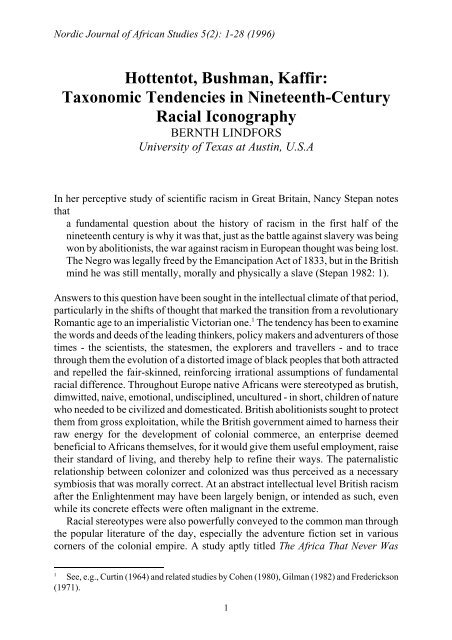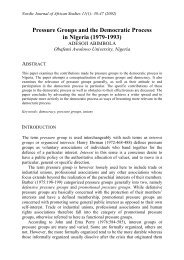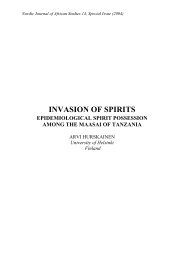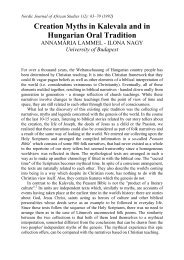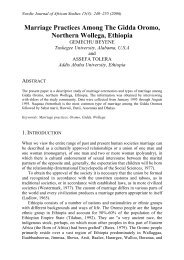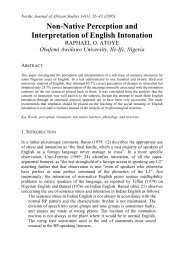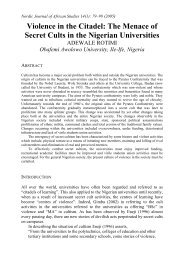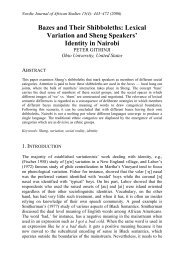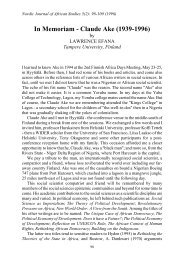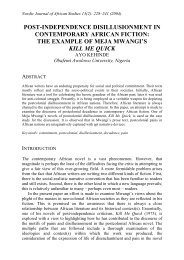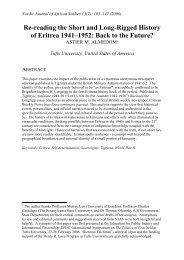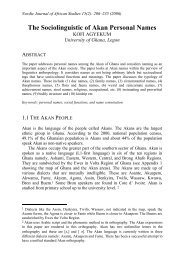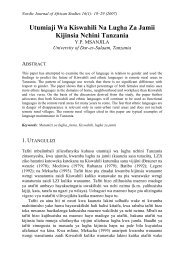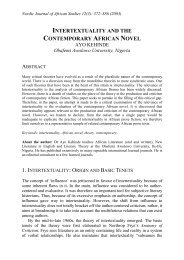Hottentot, Bushman, Kaffir: Taxonomic Tendencies in Nineteenth
Hottentot, Bushman, Kaffir: Taxonomic Tendencies in Nineteenth
Hottentot, Bushman, Kaffir: Taxonomic Tendencies in Nineteenth
Create successful ePaper yourself
Turn your PDF publications into a flip-book with our unique Google optimized e-Paper software.
Nordic Journal of African Studies 5(2): 1-28 (1996)<br />
<strong>Hottentot</strong>, <strong>Bushman</strong>, <strong>Kaffir</strong>:<br />
<strong>Taxonomic</strong> <strong>Tendencies</strong> <strong>in</strong> N<strong>in</strong>eteenth-Century<br />
Racial Iconography<br />
BERNTH LINDFORS<br />
University of Texas at Aust<strong>in</strong>, U.S.A<br />
In her perceptive study of scientific racism <strong>in</strong> Great Brita<strong>in</strong>, Nancy Stepan notes<br />
that<br />
a fundamental question about the history of racism <strong>in</strong> the first half of the<br />
n<strong>in</strong>eteenth century is why it was that, just as the battle aga<strong>in</strong>st slavery was be<strong>in</strong>g<br />
won by abolitionists, the war aga<strong>in</strong>st racism <strong>in</strong> European thought was be<strong>in</strong>g lost.<br />
The Negro was legally freed by the Emancipation Act of 1833, but <strong>in</strong> the British<br />
m<strong>in</strong>d he was still mentally, morally and physically a slave (Stepan 1982: 1).<br />
Answers to this question have been sought <strong>in</strong> the <strong>in</strong>tellectual climate of that period,<br />
particularly <strong>in</strong> the shifts of thought that marked the transition from a revolutionary<br />
Romantic age to an imperialistic Victorian one. 1 The tendency has been to exam<strong>in</strong>e<br />
the words and deeds of the lead<strong>in</strong>g th<strong>in</strong>kers, policy makers and adventurers of those<br />
times - the scientists, the statesmen, the explorers and travellers - and to trace<br />
through them the evolution of a distorted image of black peoples that both attracted<br />
and repelled the fair-sk<strong>in</strong>ned, re<strong>in</strong>forc<strong>in</strong>g irrational assumptions of fundamental<br />
racial difference. Throughout Europe native Africans were stereotyped as brutish,<br />
dimwitted, naive, emotional, undiscipl<strong>in</strong>ed, uncultured - <strong>in</strong> short, children of nature<br />
who needed to be civilized and domesticated. British abolitionists sought to protect<br />
them from gross exploitation, while the British government aimed to harness their<br />
raw energy for the development of colonial commerce, an enterprise deemed<br />
beneficial to Africans themselves, for it would give them useful employment, raise<br />
their standard of liv<strong>in</strong>g, and thereby help to ref<strong>in</strong>e their ways. The paternalistic<br />
relationship between colonizer and colonized was thus perceived as a necessary<br />
symbiosis that was morally correct. At an abstract <strong>in</strong>tellectual level British racism<br />
after the Enlightenment may have been largely benign, or <strong>in</strong>tended as such, even<br />
while its concrete effects were often malignant <strong>in</strong> the extreme.<br />
Racial stereotypes were also powerfully conveyed to the common man through<br />
the popular literature of the day, especially the adventure fiction set <strong>in</strong> various<br />
corners of the colonial empire. A study aptly titled The Africa That Never Was<br />
1 See, e.g., Curt<strong>in</strong> (1964) and related studies by Cohen (1980), Gilman (1982) and Frederickson<br />
(1971).<br />
1
Nordic Journal of African Studies<br />
documents the role imag<strong>in</strong>ative literature played <strong>in</strong> dissem<strong>in</strong>at<strong>in</strong>g farfetched racist<br />
ideas to English readers (Hammond and Jablow 1970; Killam 1968). Such<br />
value-laden discourse, directed at a mass audience, probably did more collective<br />
harm than the published papers of scientists, many of whom <strong>in</strong> the latter half of the<br />
n<strong>in</strong>eteenth century became <strong>in</strong>creas<strong>in</strong>gly preoccupied with formulat<strong>in</strong>g ’objective’<br />
racial theories based on comparisons of quantitative data derived from precise<br />
measurements of various anatomical parts, especially the skull (Gould 1981). But<br />
the subjectivity of the pop writers and the objectivity of the scientists po<strong>in</strong>ted<br />
toward the same conclusions because they were based on the same premise: that<br />
Africans were by nature <strong>in</strong>ferior to Europeans.<br />
Among men and women of conscience it was believed that this <strong>in</strong>herent<br />
difference <strong>in</strong> biological status made certa<strong>in</strong> moral demands upon the superior race.<br />
Clearly it was unethical to enslave an <strong>in</strong>ferior, but it was considered perverse to<br />
marry one. In deal<strong>in</strong>g with subnormal human be<strong>in</strong>gs some balance had to be<br />
achieved between enforc<strong>in</strong>g total social control and allow<strong>in</strong>g absolute personal<br />
freedom. Blacks had to be released from oppressive physical captivity yet kept<br />
strictly conf<strong>in</strong>ed to their proper biological niche at the bottom of the natural human<br />
ladder. The civilized and the savage had to rema<strong>in</strong> distanced from one another, if<br />
only to prevent disastrous taxonomic confusion. For otherwise the neat,<br />
color-coded dist<strong>in</strong>ctions that marked significant gradations <strong>in</strong> varieties of mank<strong>in</strong>d<br />
could become blurred and <strong>in</strong>decipherable. It would then be impossible to<br />
dist<strong>in</strong>guish at a glance between the Self and the Other.<br />
One very effective method of distanc<strong>in</strong>g Africans from Europeans was though<br />
visual images. Even the illiterate masses could understand a picture, and the picture<br />
didn't have to be accurate to convey a powerful impression. Indeed, before the<br />
advent of photography, hand-drawn sketches of black people functioned as a k<strong>in</strong>d<br />
of ocular shorthand, reduc<strong>in</strong>g complex human be<strong>in</strong>gs to a pattern of schematic l<strong>in</strong>es<br />
meant to represent their essence. Some of this racial iconography aspired to exact<br />
representation undistorted by bias or overstatement, but much of it consciously or<br />
unconsciously expressed a bigoted attitude toward the <strong>in</strong>dividual or group depicted,<br />
emphasiz<strong>in</strong>g differences that set this race apart from others. Blacks were thus made<br />
to appear less than fully human at precisely the time their full human rights were<br />
be<strong>in</strong>g secured through legislation. The paradoxes of British racial paternalism are<br />
<strong>in</strong>delibly <strong>in</strong>scribed <strong>in</strong> the visual arts of the n<strong>in</strong>eteenth century, particularly <strong>in</strong> those<br />
arts that forthrightly aided and abetted racist th<strong>in</strong>k<strong>in</strong>g.<br />
Racial arguments were advanced <strong>in</strong> media rang<strong>in</strong>g from careful illustrations <strong>in</strong><br />
scientific texts to highly exaggerated political caricatures and lampoons, from<br />
picturesque portraits <strong>in</strong> travel books to grotesque images on posters and handbills<br />
advertis<strong>in</strong>g ethnic enterta<strong>in</strong>ments. Some of the best examples of this graphic<br />
tradition can be found <strong>in</strong> depictions of three southern African peoples: the<br />
Khoikhoi, the San and the Zulu, popularly known throughout the n<strong>in</strong>eteenth century<br />
as the <strong>Hottentot</strong>, the <strong>Bushman</strong> and the <strong>Kaffir</strong>. What may have made these three<br />
African ethnic groups more visible <strong>in</strong> British art than others was the fact that<br />
specimens of each occasionally were conveyed to England and displayed publicly<br />
2
<strong>Hottentot</strong>, <strong>Bushman</strong>, <strong>Kaffir</strong><br />
as examples of uncivilized humanity. The artists who drew them therefore did not<br />
have to rely on tall tales or hearsay for their impressions but could record their own<br />
responses to liv<strong>in</strong>g creatures they could see with their own eyes, close up, and <strong>in</strong><br />
the flesh. The various distanc<strong>in</strong>g devices these artists adopted to portray such<br />
subjects tell us someth<strong>in</strong>g about racial attitudes <strong>in</strong> Brita<strong>in</strong> <strong>in</strong> the n<strong>in</strong>eteenth century,<br />
a century that began with attempts at exploration of selected parts of Africa and<br />
ended with Europe's aggressive expropriation of the entire cont<strong>in</strong>ent.<br />
1. THE HOTTENTOT VENUS<br />
The most famous African performer on the British stage <strong>in</strong> the early n<strong>in</strong>eteenth<br />
century was Sartjee Baartman, a woman who made her debut <strong>in</strong> London <strong>in</strong><br />
September 1810 and rema<strong>in</strong>ed on display <strong>in</strong> cities and towns throughout the British<br />
Isles and Europe until her death <strong>in</strong> Paris <strong>in</strong> December 1815. 2 Billed facetiously as<br />
the "<strong>Hottentot</strong> Venus," she had one remarkable attribute, a steatopygous rump, that<br />
made her an anatomical curiosity. Her manager, a Boer farmer from the Cape,<br />
sought to add further novelty to her exhibition by hav<strong>in</strong>g her emerge from a cave,<br />
perform rudimentary tasks on command, s<strong>in</strong>g, dance, and play a few melodies on a<br />
simple str<strong>in</strong>ged <strong>in</strong>strument. But the big attraction for those who came to see her was<br />
her enormous bottom, the authenticity of which some skeptics <strong>in</strong>sisted on test<strong>in</strong>g by<br />
patt<strong>in</strong>g, p<strong>in</strong>ch<strong>in</strong>g or pok<strong>in</strong>g with a cane or parasol. To spice up her act, she was<br />
outfitted <strong>in</strong> a sk<strong>in</strong>tight, sk<strong>in</strong>-colored garment that made her appear nude under her<br />
native ornaments. So this outlandish Venus offered the British public at least three<br />
k<strong>in</strong>ds of sideshow stimulation: she was part freak, part savage, part cooch dancer.<br />
The degrad<strong>in</strong>g nature of her exhibition did not please everyone who witnessed it.<br />
Members of the newly formed African Institution, led by the famous abolitionist<br />
Zachary Macaulay, took her manager to court, charg<strong>in</strong>g that this woman could not<br />
possibly have consented to be<strong>in</strong>g displayed <strong>in</strong> this humiliat<strong>in</strong>g manner, that she<br />
therefore was be<strong>in</strong>g kept <strong>in</strong> a condition of <strong>in</strong>voluntary servitude, and that under<br />
protection of British law she ought to be released from her captivity and repatriated<br />
to Africa. The petitioners also claimed that the show was <strong>in</strong>decent, but they chose<br />
to contest only the legality, not the morality, of the exhibition. Her manager flatly<br />
denied all the charges (L<strong>in</strong>dfors 1985).<br />
To settle the matter, the presid<strong>in</strong>g magistrate arranged for the woman to be<br />
<strong>in</strong>terrogated for several hours <strong>in</strong> low Dutch <strong>in</strong> the presence of witnesses for both<br />
sides. To the surprise of the pla<strong>in</strong>tiffs she testified <strong>in</strong> support of her manager,<br />
swear<strong>in</strong>g she had will<strong>in</strong>gly agreed to the terms of the contract she had with him,<br />
that she was under no restra<strong>in</strong>t but was well treated and earn<strong>in</strong>g good money, and<br />
2 The most detailed accounts of her career <strong>in</strong> show bus<strong>in</strong>ess are by Kirby (1949; 1953) and by<br />
Altick (1978). Her career <strong>in</strong> science is summed up by Gould (1982).<br />
3
Nordic Journal of African Studies<br />
that she wanted the show to go on. On the strength of this testimony the magistrate<br />
had no alternative but to dismiss the suit and allow Sartjee Baartman to cont<strong>in</strong>ue<br />
her show bus<strong>in</strong>ess career.<br />
The resolution of this unusual case, which was remarked on <strong>in</strong> all the London<br />
papers and picked up quickly by the prov<strong>in</strong>cial press, added immeasurably to the<br />
notoriety of the <strong>Hottentot</strong> Venus, mak<strong>in</strong>g her a household word throughout the<br />
British Isles. Ballads, doggerel verse, quips and jokes <strong>in</strong>spired by the <strong>in</strong>congruity of<br />
her situation began to make the rounds. Several humor magaz<strong>in</strong>es published letters<br />
<strong>in</strong> broken English purportedly written by her, and comic artists quickly jo<strong>in</strong>ed <strong>in</strong><br />
the fun, graphically <strong>in</strong>flat<strong>in</strong>g her strange tale. To susta<strong>in</strong> such hilarity, crude<br />
caricature became the dom<strong>in</strong>ant verbal and iconographic idiom. 3<br />
The best-known burlesque image of Sartjee Baartman was an aquat<strong>in</strong>t by Frederick<br />
Christian Lewis used to advertise her exhibition (Fig. 1). Its emphasis rested<br />
squarely on her buttocks, which protruded like oversized basketballs from an erect<br />
frame seen <strong>in</strong> profile. Sander L. Gilman, <strong>in</strong> a suggestive essay on the iconography<br />
of female sexuality, advances the idea that "when the n<strong>in</strong>eteenth century saw the<br />
black female, it saw her <strong>in</strong> terms of her buttocks... Female sexuality is tied to the<br />
image of the buttocks, and the qu<strong>in</strong>tessential buttocks are those of the <strong>Hottentot</strong>"<br />
(Gilman 1985). Us<strong>in</strong>g Sartjee Baartman as a spectacular case <strong>in</strong> po<strong>in</strong>t, Gilman f<strong>in</strong>ds<br />
that "it is <strong>in</strong>deed <strong>in</strong> the physical appearance of the <strong>Hottentot</strong> that the central icon for<br />
sexual difference between the European and the black was found" (Gilman 1985:<br />
83). One could go further and argue that to the European m<strong>in</strong>d the pronounced<br />
steatopygia of the <strong>Hottentot</strong> Venus not only made her appear sexually different<br />
from white women but also placed her much closer to the animal world both<br />
literally and symbolically. Her buttocks were an outward sign of her primitive<br />
nature as well as an emblem of her unbridled lust. By exaggerat<strong>in</strong>g a trait presumed<br />
to signal corporal and cultural atavism, Lewis was add<strong>in</strong>g flesh to a racial myth that<br />
dehumanized Africans.<br />
Another physiological peculiarity of <strong>Hottentot</strong> females that <strong>in</strong>creased their<br />
reputation for voluptuosity, further excit<strong>in</strong>g the curiosity of European scientists and<br />
laymen, resided <strong>in</strong> their genitalia. Early travellers <strong>in</strong> southern Africa had reported<br />
that these women possessed an "apron" of tissues that dangled between their legs to<br />
extraord<strong>in</strong>ary lengths. 4 Le Vaillant's Travels from the Cape of Good Hope <strong>in</strong>to the<br />
Interior Parts of Africa (1790) even <strong>in</strong>cluded an illustration of a woman with such<br />
appendages extend<strong>in</strong>g halfway to her knees (Fig. 2) (Le Vaillant 1790: 349). This<br />
characteristic was cited as further evidence that <strong>Hottentot</strong>s were more closely ak<strong>in</strong><br />
to apes and chimpanzees than to human be<strong>in</strong>gs. Their primitive organs po<strong>in</strong>ted<br />
toward primitive orig<strong>in</strong>s.<br />
3 For examples, see L<strong>in</strong>dfors (1984).<br />
4 See, e.g., the extract from Cowley 1960: 105-06; Rhyne 1686 (1933: 47); Kolb 1731: 118-19.<br />
4
<strong>Hottentot</strong>, <strong>Bushman</strong>, <strong>Kaffir</strong><br />
Figure l. Frederick Christian Lewis, "Sartjee, the <strong>Hottentot</strong> Venus," an aquat<strong>in</strong>t<br />
used to advertise her exhibition. This copy is from the British Museum Collection<br />
of Pr<strong>in</strong>ts and Draw<strong>in</strong>gs. For further <strong>in</strong>formation see the brief discussion <strong>in</strong> Mary<br />
Dorothy George (1978), Catalogue of Political and Personal Satires <strong>in</strong> the<br />
Department of Pr<strong>in</strong>ts and Draw<strong>in</strong>gs <strong>in</strong> the British Museum, Vol.8, No 11602, p.<br />
959.<br />
5
Nordic Journal of African Studies<br />
Figure 2. François Le Vaillant (1790), Voyage dans l'<strong>in</strong>térieur de l'Afrique par le<br />
Cap de Bonne-Esperance, Vol. 2: 349.<br />
6
<strong>Hottentot</strong>, <strong>Bushman</strong>, <strong>Kaffir</strong><br />
It is not known whether the <strong>Hottentot</strong> Venus exposed her genitals to the<br />
spectators who flocked to her shows. It is unlikely that this would have been<br />
tolerated <strong>in</strong> the British Isles as part of her public rout<strong>in</strong>e, but private view<strong>in</strong>gs may<br />
have been arranged occasionally beh<strong>in</strong>d the stage curta<strong>in</strong>, especially <strong>in</strong> Paris. One<br />
French scientific source states that Sartjee Baartman was reputed to have been a<br />
woman of amorous disposition who "did not scorn those of her admirers who had<br />
the k<strong>in</strong>d of morals that made Sodom famous" (Verneau 1916: 178). 5 Yet she is also<br />
reported to have been so modest when pos<strong>in</strong>g <strong>in</strong> the nude for a team of French<br />
anatomists and figure pa<strong>in</strong>ters that no one afterwards could say with assurance<br />
whether or not she possessed any k<strong>in</strong>d of genital anomaly, even though several<br />
casual attempts had been made to discover if she did (de Bla<strong>in</strong>ville 1816). It wasn't<br />
until the most em<strong>in</strong>ent comparative anatomist <strong>in</strong> France, Baron Georges Cuvier,<br />
dissected her body a year later and published a classic scientific paper on her<br />
buttocks and genitalia that the full truth became known. Indeed, Cuvier must be<br />
credited with hav<strong>in</strong>g f<strong>in</strong>ally unraveled the mystery of the <strong>Hottentot</strong> apron,<br />
identify<strong>in</strong>g it correctly as consist<strong>in</strong>g of noth<strong>in</strong>g more than hypertrophied nymphae.<br />
Yet his elaborate description of her person and personality is remarkable for its<br />
tendency to compare her quite matter-of-factly to an orangoutang. Cuvier is known<br />
for his belief <strong>in</strong> the fixity of species and his resistance to evolutionary theories, but<br />
apparently he was tempted to view Sartjee Baartman and her k<strong>in</strong>d as constitut<strong>in</strong>g a<br />
marg<strong>in</strong>al species, half-animal and half-human. Without go<strong>in</strong>g so far as to say so<br />
directly, he h<strong>in</strong>ted through his comparison that he regarded her as some sort of<br />
miss<strong>in</strong>g l<strong>in</strong>k (Cuvier 1817). 6<br />
Many of the European scientists who subsequently made use of Cuvier's<br />
discoveries or who <strong>in</strong>dependently took measurements of her skull, skeleton or other<br />
carefully preserved rema<strong>in</strong>s were equally conv<strong>in</strong>ced that she represented a lower<br />
order of be<strong>in</strong>g, perhaps a transitional one <strong>in</strong> human evolution. In a textbook<br />
diagram of craniometrical variation, her skull was placed midway on a cont<strong>in</strong>uum<br />
between European man and the wolf (Cloquet 1821: 80). The shape and size of her<br />
skull relegated her to this humble position.<br />
Images of Sartjee Baartman were also used to illustrate early ethnological<br />
studies, sometimes be<strong>in</strong>g placed beside idealized images of European beauty such<br />
as the Venus de Milo or the Venus de Medici (Fig. 3) (von Luschka 1864: 8).<br />
European viewers could be left to draw their own conclusions from such contrasts.<br />
In addition, she turned up regularly <strong>in</strong> illustrated encyclopedias on the races of<br />
mank<strong>in</strong>d and once even made an unexpected appearance <strong>in</strong> a comprehensive study<br />
of world costume (Rac<strong>in</strong>et 1888) .7 In most of these ’scientific’ uses of her body<br />
5 I am grateful to Mart<strong>in</strong> Sonenberg for translat<strong>in</strong>g this passage.<br />
6 For a discussion of Cuvier's role <strong>in</strong> n<strong>in</strong>eteenth-century science, see Coleman (1964).<br />
7 She is portrayed <strong>in</strong>accurately as wear<strong>in</strong>g a white body stock<strong>in</strong>g beneath her lo<strong>in</strong>cloth, beads<br />
and native ornaments.<br />
7
Nordic Journal of African Studies<br />
Figure 3. Hubert von Luschka (1864), Die Anatomie des menschlichen Beckens,<br />
Vol. 3 of Die Anatomie des Menschen <strong>in</strong> Rücksicht auf die Bedürfnisse der<br />
praktischen Heilkunde, Tüb<strong>in</strong>gen: H. Laupp, Vol. 2, p. 8.<br />
8
<strong>Hottentot</strong>, <strong>Bushman</strong>, <strong>Kaffir</strong><br />
there was a very deliberate attempt at verisimilitude, at faithful and exact<br />
reproduction of her physical characteristics. This was science, after all. No obvious<br />
distortions of surface phenomena could be permitted <strong>in</strong> an unbiased quest for truth.<br />
But the strategy underly<strong>in</strong>g the selection and placement of her image often betrayed<br />
blatant racist assumptions. Objective portraiture only served to buttress highly<br />
subjective notions about natural gradations <strong>in</strong> the variety of the human species.<br />
Caricature, an art based on flagrant distortions of reality, fed on the same<br />
assumptions and used ironic juxtapositions of European and African figures to<br />
make unspoken racial po<strong>in</strong>ts. In the earliest political cartoons based on the orig<strong>in</strong>al<br />
Lewis aquat<strong>in</strong>t, Sartjee Baartman was placed rump to rump with Lord William<br />
Wyndham Grenville, a former Whig prime m<strong>in</strong>ister who <strong>in</strong> 1810-11, when George<br />
III was show<strong>in</strong>g clear signs of irreversible mental illness, favored form<strong>in</strong>g a broadly<br />
based coalition government under the Pr<strong>in</strong>ce Regent. Grenville and his backers<br />
therefore had come to be known popularly as "Broad Bottoms," a term that<br />
"connoted the comprehensive character of the M<strong>in</strong>istry and the bulky posteriors of<br />
the Grenvilles" (George 1978: 410), so naturally they became easy targets for<br />
graphic satire. In one unsigned engrav<strong>in</strong>g entitled "A Pair of Broad Bottoms", the<br />
playwright Richard Br<strong>in</strong>sley Sheridan is shown half-kneel<strong>in</strong>g between the mirrored<br />
figures, measur<strong>in</strong>g Sartjee Baartman's bottom with calipers and exclaim<strong>in</strong>g that<br />
"such a Spanker beats your Lordship's hollow." 8<br />
In other words, here was a lowly <strong>Hottentot</strong> who had outstripped Lord Grenville<br />
<strong>in</strong> fundamental excellence; she was by far the broadest of the Broad Bottoms. The<br />
humor sprang from an <strong>in</strong>version of accepted notions of <strong>Hottentot</strong> <strong>in</strong>feriority and<br />
backwardness. Indeed, the absurdity of juxtapos<strong>in</strong>g Sartjee Baartman and Lord<br />
Grenville rested on an implicit assumption that <strong>Hottentot</strong>s and English noblemen<br />
were so radically different from one another as to be <strong>in</strong>comparable. Africans,<br />
especially <strong>Hottentot</strong>s, could not be placed on the same foot<strong>in</strong>g as Europeans, much<br />
less elevated above them. The very idea was comical.<br />
The same sort of humor <strong>in</strong>formed caricatures that dealt with Sartjee Baartman's<br />
potential as a love partner. The word "Venus" <strong>in</strong> her title was enough to trigger<br />
numerous mock-romantic visions of hearts and cupids. 9 But perhaps the best<br />
illustration of this k<strong>in</strong>d of visual gag can be found <strong>in</strong> Charles Williams's travesty of<br />
the Duke of Clarence, who <strong>in</strong> 1811 was striv<strong>in</strong>g to f<strong>in</strong>d a very wealthy woman to<br />
marry. He had proposed six times to a young heiress and then had relentlessly<br />
pursued a number of others, all of whom had turned him down. He was averag<strong>in</strong>g<br />
about one marriage proposal per month when Williams's engrav<strong>in</strong>g entitled<br />
"Neptune's Last Resource or the Fortune Hunter Foiled, a Sketch from Heathen<br />
Mythology" appeared depict<strong>in</strong>g him as a long-bearded admiral try<strong>in</strong>g to seize<br />
Sartjee Baartman's money bags. 10 The <strong>Hottentot</strong> Venus was represented as spurn<strong>in</strong>g<br />
8 George (1978), Vol. 8, No. 11578, p. 948, attributes this engrav<strong>in</strong>g to William Heath.<br />
9 See, e.g. George, Vol. 10, No. 14449, p. 338.<br />
10 George, Vol. 9, No. 11748, pp. 38-39.<br />
9
Nordic Journal of African Studies<br />
his suit, hav<strong>in</strong>g div<strong>in</strong>ed his true motive for approach<strong>in</strong>g her. Even the rudest<br />
barbarian, it was suggested, could see through the clumsy advances of the Duke of<br />
Clarence.<br />
The portrayal of Sartjee Baartman as a young woman f<strong>in</strong>ancially well-endowed<br />
and m<strong>in</strong>dful of the value of her assets may be <strong>in</strong>dicative of public awareness of her<br />
remarkable success <strong>in</strong> show bus<strong>in</strong>ess. Occasionally one f<strong>in</strong>ds <strong>in</strong> the press of that<br />
period waggish suggestions that she might now make an advantageous match for an<br />
ambitious suitor: "The damsel, it is said, has picked up some cash, and may become<br />
a desirable object <strong>in</strong> the eyes of some of our m<strong>in</strong>or fortune hunters." 11 The image of<br />
her as a female worthy of amorous attention was, of course, someth<strong>in</strong>g that the<br />
satirists cont<strong>in</strong>ued to exploit. But <strong>in</strong> Williams's caricature of the Duke of Clarence,<br />
the comic accent was on money rather than love. Any nobleman desperate enough<br />
to marry an African for f<strong>in</strong>ancial ga<strong>in</strong> clearly violated English norms of acceptable<br />
elite behavior. A duke's marriage with a <strong>Hottentot</strong> was unth<strong>in</strong>kable for it would be a<br />
betrayal of all the verities of race, class and gender.<br />
So the iconography of <strong>Hottentot</strong>s <strong>in</strong> early n<strong>in</strong>eteenth century England<br />
emphasized their biological <strong>in</strong>compatibility with Europeans. They were regarded<br />
not just as social and <strong>in</strong>tellectual <strong>in</strong>feriors but as a breed apart, a throwback to<br />
earlier evolutionary times, a rudimentary l<strong>in</strong>k <strong>in</strong> the great cha<strong>in</strong> of humanoid<br />
be<strong>in</strong>gs. And this closeness to nature, manifested <strong>in</strong> their strange anatomy and raw<br />
vitality, made them fasc<strong>in</strong>at<strong>in</strong>g and attractive to scientists, travellers, artists, and the<br />
ord<strong>in</strong>ary man on the street. They were the exotic, primitive Other aga<strong>in</strong>st whose<br />
arrested development one's own progress could be measured. The <strong>Hottentot</strong> Venus<br />
was therefore much more than a liv<strong>in</strong>g icon of sexual difference; she was Otherness<br />
personified - a s<strong>in</strong>g<strong>in</strong>g, danc<strong>in</strong>g, jiggl<strong>in</strong>g <strong>in</strong>carnation of one extreme <strong>in</strong> a rigidly<br />
hierarchical taxonomic paradigm. She gave body to racist theory.<br />
2. THE BOSJESMANS AND THE EARTHMEN<br />
The San who were exhibited <strong>in</strong> the British Isles were also assumed to be among the<br />
very dregs of humanity. The first troupe, consist<strong>in</strong>g of two men, two women and an<br />
<strong>in</strong>fant, arrived <strong>in</strong> 1846, shortly after P.T. Barnum's Tom Thumb had stormed<br />
Europe, populariz<strong>in</strong>g the display of unusual small people. 12 In newspaper<br />
11 Daniel Lysons, Collectanea; or a Collection of Advertisements and Paragraphs from the<br />
Newspapers, Relat<strong>in</strong>g to Various Subjects, Vol. 2. This unpublished scrapbook is available only<br />
at the British Library (1881.b.6).<br />
12 Tom Thumb's first European tour had started <strong>in</strong> London <strong>in</strong> 1844. At the end of the summer of<br />
1845 two "Bushmen Children" had been exhibited <strong>in</strong> London for a short time, but they do not<br />
appear to have made much of an impact and vanished quickly from the stage; a sketch of them<br />
was published <strong>in</strong> the Illustrated London News, September 6th 1845, p. 160. The Bosjesmans, on<br />
the other hand, rema<strong>in</strong>ed on tour for several years and were a very popular attraction. There is<br />
evidence to suggest that they were abandoned <strong>in</strong> Rouen by an unscrupulous manager <strong>in</strong><br />
December 1853 (see Goblot 1983: 40).<br />
10
<strong>Hottentot</strong>, <strong>Bushman</strong>, <strong>Kaffir</strong><br />
advertisements the manager of the "Bosjesmans" claimed that these dwarfish folk<br />
and their few crude implements<br />
show how very nearly sentient be<strong>in</strong>gs may s<strong>in</strong>k to, or rather have never risen<br />
above, the condition of animals unendowed with reason to guide or govern their<br />
<strong>in</strong>st<strong>in</strong>ctive propensities....They are supposed to belong to one of the numerous<br />
tribes of their benighted country which have not yet emerged from absolute<br />
barbarism (Liverpool Mail, November 14th 1846, p. 3).<br />
Apart from their small size and odd facial features, what appears to have made the<br />
Bosjesmans particularly fasc<strong>in</strong>at<strong>in</strong>g was their life style, which was utterly different<br />
from that of any people the British had ever encountered before: they owned very<br />
few possessions, used only the simplest tools, built no permanent structures, and<br />
wore hardly any cloth<strong>in</strong>g. All these traits could have been traced to the fact that<br />
they were a hunt<strong>in</strong>g and gather<strong>in</strong>g people and therefore had no need for belong<strong>in</strong>gs<br />
or paraphernalia that would impede their mobility, but the British <strong>in</strong>terpreted a lack<br />
of th<strong>in</strong>gs as a lack of culture and thought less of the Bosjesmans as a result.<br />
Commentators tended to agree with the oft-quoted assessment offered by the<br />
learned traveller Dr. Lichtenste<strong>in</strong> that<br />
there is not perhaps any class of savages upon the earth that lead lives so near<br />
those of the brutes as the Bosjesmans; none perhaps who are sunk so low, who<br />
are so unimportant <strong>in</strong> the scale of existence; whose wants, whose cares, and<br />
whose joys, are so low <strong>in</strong> their nature; and who are consequently so little capable<br />
of cultivation. 13<br />
In short, the Bosjesmans were presumed to be an utterly hopeless lot.<br />
Nonetheless, thousands of spectators turned out to see them, if only to confirm at<br />
an <strong>in</strong>timate but safe distance xenophobic prejudices aga<strong>in</strong>st brutish be<strong>in</strong>gs from the<br />
Dark Cont<strong>in</strong>ent. Charles Dickens probably summed up the public reaction best<br />
when he wrote:<br />
Th<strong>in</strong>k of the Bushmen. Th<strong>in</strong>k of the two men and the two women who have<br />
been exhibited about England for some years. Are the majority of persons - who<br />
remember the horrid little leader of that party <strong>in</strong> his fester<strong>in</strong>g bundle of hides,<br />
with his filth and his antipathy to water, and his straddled legs, and his odious<br />
eyes shaded by his brutal hand, and his cry of "Qu-u-u-u-aaa!" (Bosjesman for<br />
someth<strong>in</strong>g desperately <strong>in</strong>sult<strong>in</strong>g I have no doubt) - conscious of an affectionate<br />
yearn<strong>in</strong>g towards that noble savage, or is it idiosyncratic <strong>in</strong> me to abhor, detest,<br />
abom<strong>in</strong>ate, and abjure him? I have no reserve on this subject, and will frankly<br />
13 Quoted on page 19 of History of the Bosjesmans, or Bush People; the Aborig<strong>in</strong>es of Southern<br />
Africa (London: Chapman, Elcoate & Co., 1847), a pamphlet sold at later shows. M.H.C.<br />
Lichtenste<strong>in</strong>'s Reisen im südlichen Afrika <strong>in</strong> den Jahren 1803, 1804, 1805 and 1806 (Berl<strong>in</strong>,<br />
1811-12), first published <strong>in</strong> English translation <strong>in</strong> London (1812-15), was subsequently reissued<br />
as Travels <strong>in</strong> Southern Africa <strong>in</strong> the Years 1803, 1804, 1805 and 1806 (Cape Town: Van<br />
Riebeeck Society, 1928). This quote is taken from the latter edition, Vol. 2, p. 244.<br />
11
Nordic Journal of African Studies<br />
state that, sett<strong>in</strong>g aside that stage of the enterta<strong>in</strong>ment when he counterfeited the<br />
death of some creature he had shot, by lay<strong>in</strong>g his head on his hand and shak<strong>in</strong>g<br />
his left leg - at which time I th<strong>in</strong>k it would have been justifiable homicide to slay<br />
him - I have never seen that group sleep<strong>in</strong>g, smok<strong>in</strong>g, and expectorat<strong>in</strong>g round<br />
their brazier, but I have s<strong>in</strong>cerely desired that someth<strong>in</strong>g might happen to the<br />
charcoal smoulder<strong>in</strong>g there<strong>in</strong>, which would cause the immediate suffocation of<br />
the whole of the noble strangers (Dickens 1853: 337-38).<br />
Dickens was debunk<strong>in</strong>g the Romantic myth of the Noble Savage but he wasn't<br />
entirely jok<strong>in</strong>g. Believ<strong>in</strong>g as he did that the Noble Savage's "virtues are a fable; his<br />
happ<strong>in</strong>ess is a delusion; his nobility, nonsense" and that "the world will be all the<br />
better when his place knows him no more," Dickens recommended more than<br />
half-seriously that it would be "someth<strong>in</strong>g highly desirable" for all such people to<br />
be "civilized off the face of the earth" (Dickens 1853: 339). If this wasn't a cry for<br />
literal genocide, it must at least be recognized as a call for cultural genocide, which<br />
perhaps amounts to the same th<strong>in</strong>g.<br />
Dickens wasn't their only detractor. Pictorial representations of the Bosjesmans<br />
<strong>in</strong> the media of the day were not at all flatter<strong>in</strong>g, the consensus among observers<br />
be<strong>in</strong>g that these were exceed<strong>in</strong>gly ugly creatures who differed as much from<br />
Europeans <strong>in</strong> appearance as <strong>in</strong> <strong>in</strong>telligence. To heighten the contrast between<br />
savage and civilized, some illustrated papers such as the Pictorial Times and<br />
Sportsman's Magaz<strong>in</strong>e pr<strong>in</strong>ted sketches of the Bosjesmans danc<strong>in</strong>g wildly while<br />
their fashionably dressed exhibitor stood sedately <strong>in</strong> the background look<strong>in</strong>g on<br />
(Fig. 4). 14 For the show itself a large poster was prepared, illustrated with scenes<br />
said to be typical of Bosjesman life: "Quarrels of <strong>Bushman</strong>," "Fight of <strong>Bushman</strong>,"<br />
"Trac<strong>in</strong>g the Footsteps of the Enemy," "Kill<strong>in</strong>g the Puff Adder," "Prepar<strong>in</strong>g for<br />
Dance," etc. Significantly, the borders between the vignettes were lurid with snakes<br />
and animal heads. 15 Less sensational images of the women and child <strong>in</strong> the troupe<br />
were used <strong>in</strong> the fourth edition of a lead<strong>in</strong>g ethnological textbook, James Cowles<br />
Prichard's The Natural History of Man (1855), but even these "scientific" plates did<br />
not make them look attractive (Prichard 1855: plates xvii and xviii). David<br />
Liv<strong>in</strong>gstone may have been right when he said of the Bosjesmans that "the<br />
specimens brought to Europe have been selected, like costermonger's dogs, on<br />
account of their extreme ugl<strong>in</strong>ess." But one wonders if he was justified <strong>in</strong> mak<strong>in</strong>g a<br />
still more demean<strong>in</strong>g comparison: "That they are, to some extent, like baboons is<br />
14 Pictorial Times, June 12th 1847, p. 376; Sportsman's Magaz<strong>in</strong>e, July 10th 1847, p. 319.<br />
Although the sketch is the same <strong>in</strong> both papers, the Pictorial Times identifies the figure <strong>in</strong> the<br />
background as Dr. Robert Knox, while Sportsman's Magaz<strong>in</strong>e says he is Mr. J.S. Tyler. Knox,<br />
an Ed<strong>in</strong>burgh anatomist who had been <strong>in</strong>volved <strong>in</strong> the notorious Burke and Hare scandal, gave an<br />
anthropological lecture as part of the show; Tyler was the manager who accompanied the<br />
Bosjesmans on their tour. The Illustrated London News, June 12th 1847, p. 381, pr<strong>in</strong>ted a<br />
similar sketch of the group and identified the gentleman sitt<strong>in</strong>g <strong>in</strong> the background as Tyler.<br />
15 This poster is preserved <strong>in</strong> the John Johnson Collection, Bodleian Library, Oxford University.<br />
12
<strong>Hottentot</strong>, <strong>Bushman</strong>, <strong>Kaffir</strong><br />
true, just as these are <strong>in</strong> some po<strong>in</strong>ts frightfully human" (Liv<strong>in</strong>gstone 1875: 35).<br />
Whether this was a fair assessment or not, British artists and illustrators who drew<br />
the Bosjesmans evidently agreed with it entirely.<br />
Figure 4. Pictorial Times, June 12th 1847, p. 376.<br />
13
Nordic Journal of African Studies<br />
Figure 5. Illustrated London News, November 6th 1852, p. 372.<br />
14
<strong>Hottentot</strong>, <strong>Bushman</strong>, <strong>Kaffir</strong><br />
This is not to say that the British eye was <strong>in</strong>capable of appreciat<strong>in</strong>g <strong>Bushman</strong><br />
beauty. The public reaction several years later to the exhibition of a<br />
fourteen-year-old boy and a sixteen-year-old girl mislead<strong>in</strong>gly identified as<br />
"Earthmen from Port Natal" was quite favorable, <strong>in</strong> part because they were much<br />
better-look<strong>in</strong>g specimens than their predecessors. Several papers carried handsome<br />
sketches of them, 16 and the Illustrated London News (Fig. 5) noted with approval<br />
their "pleas<strong>in</strong>g hue... lustrous black eyes... perfect docility and mildness of<br />
disposition... good natural faculties... (and) excellent ear for music... Mart<strong>in</strong>us is a<br />
f<strong>in</strong>e little savage, beautifully formed, and with well developed muscles. Flora is<br />
also a nicely-made child, of more slender and delicate frame, but perfectly healthy"<br />
(Illustrated London News, Nov. 6th 1852: 371). A handbill for one of their shows<br />
claimed that they were "the only Specimens of this Extraord<strong>in</strong>ary Race ever beheld<br />
<strong>in</strong> Europe," 17 but this was questioned by a number of <strong>in</strong>formed spectators. They had<br />
been dubbed "Earthmen" because <strong>in</strong> South Africa they were alleged to have slept <strong>in</strong><br />
hollows <strong>in</strong> the ground made by burrow<strong>in</strong>g; however, members of the English<br />
Ethnological Society, not<strong>in</strong>g their resemblance to the Bosjesmans, preferred to<br />
classify them as "<strong>Bushman</strong>-Troglodytes, or Troglodyte-Bushmen." 18<br />
Like other human curiosities before them, Mart<strong>in</strong>us and Flora danced, sang and<br />
mimed to enterta<strong>in</strong> their customers, but their ’act’ differed <strong>in</strong> one important respect:<br />
they performed entirely <strong>in</strong> English. They were able to do this because they had<br />
lived for two years with a British family <strong>in</strong> Croydon before be<strong>in</strong>g put on stage.<br />
Dur<strong>in</strong>g that time they had acquired a fluency <strong>in</strong> English, had learnt to play the<br />
piano, and had built up a repertoire of songs that <strong>in</strong>cluded "Buffalo Gals," "I'm<br />
Go<strong>in</strong>g to Alabama," "Annie Laurie," "Britons Never Shall be Slaves," and a number<br />
of black American tunes. Their musical talents were much admired, but audiences<br />
were most impressed by their mastery of a "civilized" tongue. One prov<strong>in</strong>cial paper<br />
reported that "the most <strong>in</strong>terest<strong>in</strong>g part of the séance is found to consist <strong>in</strong> the<br />
spritely conversation they carry on with their visitors" (Brighton Guardian, Oct.<br />
5th 1853: 5.), and another exclaimed that "their knowledge of the English language,<br />
together with their musical proficiency, is very remarkable for the time they have<br />
been <strong>in</strong> this country, show<strong>in</strong>g even a greater <strong>in</strong>telligence than that ev<strong>in</strong>ced generally<br />
16 London Journal and Weekly Record of Literature, Science and Art, 17 (1853: 325); The<br />
Illustrated Magaz<strong>in</strong>e of Art, 1 (1853: 445); Illustrated London News, November 6th 1852, p.<br />
372.<br />
17 Regent Gallery handbill, hand-dated August 22nd 1853, <strong>in</strong> the John Johnson Collection,<br />
Bodleian Library, Oxford University.<br />
18 Latham (1856: 149). John Conolly, the President of the Ethnological Society, <strong>in</strong> his The<br />
Ethnological Exhibitions of London (1855: 27-28), stated that “The name of Earthmen, given to<br />
these little Africans, is of very doubtful propriety, and associated with a more than doubtful<br />
account of their liv<strong>in</strong>g <strong>in</strong> holes burrowed <strong>in</strong> the earth; for which their delicate feet and hands<br />
seem unfitted, and for effect<strong>in</strong>g which they are said not to have implements or utensils of bone,<br />
wood, iron or other material. It is very probable that they partly cover themselves with leaves or<br />
loose earth, not very dissimilar to them <strong>in</strong> colour, when they wish to elude observation. This is<br />
said to be the practise of the Bosjesmen.”<br />
15
Nordic Journal of African Studies<br />
by the more civilized children of our own country" (Brighton Exam<strong>in</strong>er, Oct. 11th<br />
1853: 5). To such observers Mart<strong>in</strong>us and Flora were miracles of transformation,<br />
savages turned to some extent genteel, base Earthmen transmuted with<strong>in</strong> two years<br />
<strong>in</strong>to reasonable facsimiles of pure English folk. More than anyth<strong>in</strong>g else, it was<br />
their ability to chatter and s<strong>in</strong>g <strong>in</strong> English that made them recognizable as fellow<br />
human be<strong>in</strong>gs; such lively <strong>in</strong>terlocutors could not possibly be mistaken for<br />
baboons, orangoutangs or other species of monkeys. Soon Mart<strong>in</strong>us and Flora were<br />
be<strong>in</strong>g hailed as "a direct Contradiction to the Theory lately set forth, of the<br />
Impossibility of Render<strong>in</strong>g the Savage a Th<strong>in</strong>k<strong>in</strong>g, Feel<strong>in</strong>g Be<strong>in</strong>g." 19 Given this<br />
high degree of enthusiastic public acceptance, it is not surpris<strong>in</strong>g that these<br />
youngsters were treated more k<strong>in</strong>dly by graphic artists than the Bosjesmans had<br />
been. Their basic humanity was never <strong>in</strong> question.<br />
3. THE ZULU KAFFIRS<br />
Dur<strong>in</strong>g the same month of 1853 that the Earthmen were first exhibited, another<br />
troupe of South African performers arrived on the London scene. 20 These were the<br />
"Zulu <strong>Kaffir</strong>s" - eleven men, a woman and a child - who performed events alleged<br />
to be representative of the tenor of their brutish life. Of all South African peoples,<br />
the Zulus may have been the most notorious abroad for their warlike ways. Reports<br />
of the military prowess of this "wild and formidable race” (The Court Journal,<br />
May 7th 1853: 300) had been filter<strong>in</strong>g back to England ever s<strong>in</strong>ce the reign of<br />
Shaka thirty years before. After England annexed Natal <strong>in</strong> 1843, emigration to the<br />
new colonial territory was encouraged, and with<strong>in</strong> ten years thousands of British<br />
settlers found themselves shar<strong>in</strong>g an unstable frontier with Zulu farmers and<br />
herders. So there must have been considerable curiosity back home about the<br />
aggressive natives who <strong>in</strong>habited this remote corner of the empire and occasionally<br />
made trouble for kith and k<strong>in</strong>.<br />
But even without such a reputation, the Zulus would have been an <strong>in</strong>terest<strong>in</strong>g<br />
novelty <strong>in</strong> Victorian England, for they put on an excit<strong>in</strong>g show, display<strong>in</strong>g<br />
themselves and their traditions with un<strong>in</strong>hibited energy yet with remarkably<br />
professional stage presence. The Times gave the spectacle a rave review:<br />
Now the Caffres are at their meal, feed<strong>in</strong>g themselves with enormous spoons,<br />
and express<strong>in</strong>g their satisfaction by a wild chant, under the <strong>in</strong>spiration of which<br />
they bump themselves along without ris<strong>in</strong>g <strong>in</strong> a sort of circular dance. Now the<br />
witchf<strong>in</strong>der commences his operations to discover the culprit whose magic has<br />
brought sickness <strong>in</strong>to the tribe, and becomes perfectly rabid through the effect of<br />
his own <strong>in</strong>cantations. Now there is a wedd<strong>in</strong>g ceremony, now a hunt, now a<br />
19 Regent Gallery handbill, hand-dated August 22nd 1853, <strong>in</strong> the John Johnson Collection,<br />
Oxford University.<br />
20 They opened at St. George's Gallery at Hyde Park Corner on May 16th 1853 and rema<strong>in</strong>ed <strong>in</strong><br />
London for three months before go<strong>in</strong>g on to tour the Cont<strong>in</strong>ent.<br />
16
<strong>Hottentot</strong>, <strong>Bushman</strong>, <strong>Kaffir</strong><br />
military expedition, all with characteristic dances; and the whole ends with a<br />
general conflict between rival tribes. The songs and dances are, as may be<br />
expected, monotonous <strong>in</strong> the extreme, and without the bill it would be difficult<br />
to dist<strong>in</strong>guish the expression of love from the gesture of martial defiance.<br />
Nevertheless, as a picture of manners, noth<strong>in</strong>g can be more complete; and not<br />
the least remarkable part of the exhibition is the perfect tra<strong>in</strong><strong>in</strong>g of the wild<br />
artists. They seem utterly to lose all sense of their present position, and, <strong>in</strong>spired<br />
by the situations <strong>in</strong> which they are placed, appear to take Mr. Marshall's scenes<br />
for their actual abode <strong>in</strong> the vic<strong>in</strong>ity of Port Natal. If ll English actors could be<br />
found so completely to lose themselves <strong>in</strong> the characters they assumed,<br />
histrionic art would be <strong>in</strong> a state truly magnificent (Times, May 18th 1853: 8.).<br />
The reviewer for The Spectator, equally impressed, ma<strong>in</strong>ta<strong>in</strong>ed that "the exhibition<br />
transcends all others we have witnessed of the k<strong>in</strong>d... As for the noises - the howls,<br />
yells, hoots and whoops, the snuffl<strong>in</strong>g, wheez<strong>in</strong>g, bubbl<strong>in</strong>g, grovell<strong>in</strong>g and<br />
stamp<strong>in</strong>g - they form a concert to whose savagery we cannot attempt to do justice"<br />
(Spectator, May 21st 1853: 485). The Illustrated London News, which carried a<br />
sketch of the performers <strong>in</strong> action (Fig. 6), praised some of the same scenes and<br />
sound effects and concluded that "the Zulus must be naturally good actors; for a<br />
performance more natural and less like act<strong>in</strong>g is seldom if ever seen upon any<br />
stage" (Illustrated London News, May 28th 1853: 409).<br />
Indeed, it was a performance by this very troupe that prompted Dickens's comic<br />
diatribe on "The Noble Savage," for he found much to ridicule and noth<strong>in</strong>g to<br />
admire <strong>in</strong> their dramatization of Zulu life. Parts of the exhibition, he asserted, were<br />
totally <strong>in</strong>comprehensible to a cultivated m<strong>in</strong>d:<br />
What a visitor left to his own <strong>in</strong>terpret<strong>in</strong>gs and imag<strong>in</strong><strong>in</strong>gs might suppose these<br />
noblemen to be about, when they give vent to that pantomimic expression which<br />
is quite settled to be the natural gift of the noble savage, I cannot possibly<br />
conceive; for it is so much too lum<strong>in</strong>ous for my personal civilisation that it<br />
conveys no idea to my m<strong>in</strong>d beyond a general stamp<strong>in</strong>g, ramp<strong>in</strong>g, and rav<strong>in</strong>g,<br />
remarkable (as everyth<strong>in</strong>g <strong>in</strong> savage life is) for its dire uniformity (Dickens<br />
1853: 338).<br />
Dickens went on to recount <strong>in</strong> hilarious detail the customs and traditions he saw<br />
enacted before him - everyth<strong>in</strong>g from murder and mayhem to witchcraft and<br />
wedd<strong>in</strong>gs - and concluded that "if we have anyth<strong>in</strong>g to learn from the Noble<br />
Savage, it is what to avoid" (Dickens 1853: 339).<br />
Dickens of course was also to some extent play<strong>in</strong>g a theatrical role himself: that<br />
of an impatient Victorian pragmatist eager to puncture <strong>in</strong>flated Romantic notions of<br />
the dignity of "primitive" peoples. For him the Zulus were simply a convenient case<br />
<strong>in</strong> po<strong>in</strong>t, a group so far removed from Europe <strong>in</strong> custom and culture that they could<br />
17
Nordic Journal of African Studies<br />
Figure 6. Illustrated London News, May 28th 1853, p. 409.<br />
easily be held up as examples of an underdeveloped race obviously <strong>in</strong> need of<br />
moral improvement and mental ref<strong>in</strong>ement. Yet it is <strong>in</strong>terest<strong>in</strong>g to note with what<br />
contempt he and other humorists viewed Zulu traditions and <strong>in</strong>stitutions, for<br />
underly<strong>in</strong>g such ethnic satire was a broad streak of undisguised racism, a belief that<br />
Zulus were <strong>in</strong> every way <strong>in</strong>ferior to Europeans. The numerous comments on their<br />
smell, their bizarre modes of dress (and undress), their noises, their monotonous<br />
songs, rabid <strong>in</strong>cantations, and wild, demoniacal dances, betray an arrogant<br />
assumption that the Zulus were overgrown children of nature who had not yet<br />
developed the <strong>in</strong>hibitions, self-discipl<strong>in</strong>e and polite manners that dist<strong>in</strong>guish more<br />
civilized folk. They were savages pure and simple, primitives <strong>in</strong> the raw.<br />
Zulu savagery became an iconographic cliché later <strong>in</strong> the century, especially<br />
dur<strong>in</strong>g and after the Anglo-Zulu wars. Issues of the Illustrated London News and<br />
other pictorial mass media <strong>in</strong> 1879 were full of gory battle scenes display<strong>in</strong>g heroic<br />
British soldiers and settlers struggl<strong>in</strong>g manfully aga<strong>in</strong>st ferocious hordes of<br />
spear-wield<strong>in</strong>g warriors. The popular adventure fiction of H. Rider Haggard, G.A.<br />
Henty, Bertram Mitford and others, while sometimes respectful of Zulu courage or<br />
chivalry, conta<strong>in</strong>ed illustrations re<strong>in</strong>forc<strong>in</strong>g the notion of such people as militaristic<br />
and fiendishly dangerous. 21 Perhaps the s<strong>in</strong>gle exception to this iconographic<br />
21 See, e.g., the illustrations <strong>in</strong> Haggard (1887; 1892), Henty (1885) and Mitford (1893; 1894).<br />
18
<strong>Hottentot</strong>, <strong>Bushman</strong>, <strong>Kaffir</strong><br />
tradition was the Spy portrait <strong>in</strong> Vanity Fair of the deposed Zulu monarch<br />
Cetewayo, who lived for a time <strong>in</strong> London; he was shown dressed rather modestly<br />
<strong>in</strong> a grey suit, cravat and blue slippers, and seated quietly on a divan (Vanity Fair,<br />
August 26th 1882). But his enormous bulk and toothy gr<strong>in</strong> connoted that he was<br />
still an unpredictable force to be reckoned with. His seem<strong>in</strong>gly <strong>in</strong>nocuous<br />
appearance contrasted all too sharply with his reputation for barbarism. The Spy<br />
cartoon thus played upon a perceptual <strong>in</strong>congruity: here was a notorious savage<br />
deceptively clad <strong>in</strong> civilized costume.<br />
Fed by such media images, public curiosity about Zulus peaked <strong>in</strong> the last two<br />
decades of the n<strong>in</strong>eteenth century, and well-known writers and showmen tried to<br />
capitalize on their trend<strong>in</strong>ess. George Bernard Shaw <strong>in</strong>cluded Cetewayo and his<br />
ret<strong>in</strong>ue <strong>in</strong> Cashel Byron's Profession (1886), a novel about box<strong>in</strong>g; and P.T.<br />
Barnum was so eager to obta<strong>in</strong> Zulus for his shows that he offered Queen Victoria's<br />
government $l00,000 for permission to exhibit Cetewayo for five years, a petition<br />
that did not amuse the Queen (Wallace 1959: 111). A rival showman outdid<br />
Barnum by putt<strong>in</strong>g on display not only three of Cetewayo's nieces (whom he billed<br />
as the chief's daughters, true "Zulu pr<strong>in</strong>cesses") but also a baby, another Zulu chief,<br />
and twenty-three warriors who had surrendered to British authorities <strong>in</strong> South<br />
Africa; it has been reported that "their arrival <strong>in</strong> London was greeted by over one<br />
hundred thousand people on the docks and as far up the street as the eye could<br />
reach." 22 Other showmen couldn't ignore such palpable signs of popularity, and<br />
soon spears, shields, feathers and war pa<strong>in</strong>t could be found <strong>in</strong> abundance <strong>in</strong> every<br />
carnival sideshow as well as <strong>in</strong> circus ’specs’ or open<strong>in</strong>g pageants. Any subterfuge<br />
that could be of advantage was used: a handbill for an exhibition of "Far<strong>in</strong>i's<br />
Friendly Zulus" at the Royal Aquarium <strong>in</strong> September 1880 brazenly quoted<br />
accolades from the Times review of the 1853 Zulu <strong>Kaffir</strong>s as if these praises had<br />
recently been bestowed on the Far<strong>in</strong>i troupe (Fig. 7).<br />
Needless to say, many of the Zulus hauled up for public display were frauds.<br />
More than one circus veteran has commented on this <strong>in</strong> his memoirs:<br />
I recollect at the time of the Zulu war how one showman conceived the idea of<br />
exhibit<strong>in</strong>g a number of Zulu warriors. There was only one drawback - not a<br />
s<strong>in</strong>gle Zulu was at that moment <strong>in</strong> the country. But drawbacks do not exist for<br />
the born showman and a party of ord<strong>in</strong>ary niggers were easily made up <strong>in</strong>to<br />
Cetewayo's savage soldiery (Walker 1922: 130).<br />
22 Coup (1901: 166). The same show may have gone to the United States, for a poster for W.C.<br />
Coup's United Monster Shows at the Great Paris Hippodrome <strong>in</strong> Chicago <strong>in</strong> 1881 advertises<br />
"Pr<strong>in</strong>cess Amazulu, K<strong>in</strong>g Cetewayo's Daughter and Suite." A newspaper advertisement for the<br />
same circus the follow<strong>in</strong>g year bills "Zulu Pr<strong>in</strong>cess Amadage, daughter of K<strong>in</strong>g Cetewayo, and<br />
her maids of honor"; these women were also said to be "the only Female Zulus who ever left<br />
Zululand and the only genu<strong>in</strong>e Zulus <strong>in</strong> America." These materials can be found at the Circus<br />
World Museum, Baraboo, Wiscons<strong>in</strong>.<br />
19
Nordic Journal of African Studies<br />
Figure 7. Royal Aquarium handbill hand-dated 28 September, 1880. From my own<br />
collection of ethnic iconography.<br />
20
<strong>Hottentot</strong>, <strong>Bushman</strong>, <strong>Kaffir</strong><br />
Managers <strong>in</strong> this k<strong>in</strong>d of show bus<strong>in</strong>ess quickly learned that pseudo-Zulus were far<br />
easier to handle than real ones. When James Lloyd engaged a dozen bonafide<br />
tribesmen for a show that toured Ireland, he found that<br />
Their wildness (<strong>in</strong> perform<strong>in</strong>g dances) was disturb<strong>in</strong>gly genu<strong>in</strong>e; this be<strong>in</strong>g one<br />
of the disadvantages encountered by showmen who, with more honesty than<br />
aesthetic perception, prefer Nature to Art. Nature, it has been said, is pull<strong>in</strong>g up<br />
on Art; but she has still a long way to go before she produces savages who are<br />
equal to the other for show purposes (McKechnie n.d., p. 210).<br />
By the end of the century it appeared that Art had overtaken Nature, that pa<strong>in</strong>ted<br />
Irishmen or <strong>in</strong>digenous British blacks were now displac<strong>in</strong>g true Africans <strong>in</strong> British<br />
show bus<strong>in</strong>ess.<br />
The pseudo-Zulu eventually became a stock comic character like the "nigger<br />
m<strong>in</strong>strel," a humorous stereotype recognized and accepted as a gross exaggeration.<br />
Almost anybody could play the part. James T. Tanner, <strong>in</strong> his 1896 musical "My<br />
Girl," took the unusual step of cast<strong>in</strong>g a "genu<strong>in</strong>e negro (Mr. W. Downes)" <strong>in</strong> the<br />
role of a pseudo-Zulu pr<strong>in</strong>ce who performed an athletic "witch-song and dance". 23<br />
The drama ended with the other characters discover<strong>in</strong>g that this negro <strong>in</strong> savage<br />
dress was neither a Zulu nor a pr<strong>in</strong>ce but a brazen imposter who was not as black as<br />
he seemed. Such an end<strong>in</strong>g reveals that the stereotype had already taken on a life of<br />
its own, spawn<strong>in</strong>g a tradition of humorous <strong>in</strong>authenticity.<br />
But then <strong>in</strong> 1899 an extravaganza called "Savage South Africa," certa<strong>in</strong>ly the<br />
biggest spectacle of its k<strong>in</strong>d ever presented to the British public, opened at the<br />
Empress Theatre <strong>in</strong> London (The Sketch, May 3rd 1899: 47-48). Organized by<br />
Frank Fillis, a South African circusman, it <strong>in</strong>cluded two hundred genu<strong>in</strong>e "natives"<br />
who, along with twenty Boers, reenacted episodes from the Matabele Rebellion.<br />
These performers also participated <strong>in</strong> the Greater Brita<strong>in</strong> Exhibition at Earl's Court<br />
<strong>in</strong> May of that year, and some of them later were recruited for support<strong>in</strong>g roles <strong>in</strong> a<br />
Boer War Exhibition that toured Europe and made a sensation at the 1904 World's<br />
Fair <strong>in</strong> St. Louis. In England there was public concern voiced <strong>in</strong> the media about<br />
the friendl<strong>in</strong>ess of some of these African men toward British women and vice versa:<br />
...why do so many women take pleasure <strong>in</strong> touch<strong>in</strong>g and patt<strong>in</strong>g and even<br />
strok<strong>in</strong>g these black persons? These blacks do not represent the highest, but the<br />
lowest <strong>in</strong> man. If the Earl's Court savages were a collection of astronomers or<br />
physiologists, if they were <strong>in</strong> any way noted for their bra<strong>in</strong> power they would<br />
create no <strong>in</strong>terest at all among women of this k<strong>in</strong>d. M<strong>in</strong>ds weigh not at all<br />
aga<strong>in</strong>st matter with many women. It is not a pleasant th<strong>in</strong>g to say; but this Earl's<br />
Court show has not tended to show the niceness of women (Shephard 1984: 40).<br />
23 See the review of this production <strong>in</strong> the Times, July 14th 1896, p. 11.<br />
21
Nordic Journal of African Studies<br />
Figure 8. Dudley Hardy, "<strong>Kaffir</strong>s Boom<strong>in</strong>g," a caricature from my own collection.<br />
22
<strong>Hottentot</strong>, <strong>Bushman</strong>, <strong>Kaffir</strong><br />
Another paper, after not<strong>in</strong>g that "grown women not only shake hands with them but<br />
stroke their limbs admir<strong>in</strong>gly," jo<strong>in</strong>ed the mascul<strong>in</strong>e chorus of disapproval:<br />
Noth<strong>in</strong>g is left undone by certa<strong>in</strong> misled English females to gratify the vanity of<br />
these miscellaneous African natives <strong>in</strong> whose delightful manners and customs<br />
this show is presumed to <strong>in</strong>struct us. The <strong>Kaffir</strong> Exhibition at Earl's Court has <strong>in</strong><br />
fact degenerated <strong>in</strong>to an exhibition of white women visitors, and a very<br />
disgust<strong>in</strong>g exhibition it is. These raw, hulk<strong>in</strong>g and untamed men-animals are<br />
be<strong>in</strong>g unwill<strong>in</strong>gly and utterly corrupted by unseemly attention from English girls<br />
(Cited <strong>in</strong> Scobie 1972: 124).<br />
The situation got worse <strong>in</strong> July when there was an actual attempt at marriage<br />
between the leader of the Matabele troupe, "Pr<strong>in</strong>ce" Peter Lobengula, and a white<br />
woman, Miss Kitty Jewell, daughter of a Cornish m<strong>in</strong><strong>in</strong>g eng<strong>in</strong>eer who had<br />
emigrated to South Africa. 24 The managers of "Savage South Africa," the local<br />
vicar, the Chancellor of the Diocese of London, and Kitty's mother closed ranks and<br />
succeeded <strong>in</strong> thwart<strong>in</strong>g the marriage, but not before the affair had generated heated<br />
vituperations <strong>in</strong> the press aga<strong>in</strong>st the evils of miscegenation. A milder critique of<br />
such heterosexual co-m<strong>in</strong>gl<strong>in</strong>g appeared <strong>in</strong> a caricature by Dudley Hardy entitled<br />
"<strong>Kaffir</strong>s Boom<strong>in</strong>g." (Fig. 8). If noth<strong>in</strong>g else, this well-publicized <strong>in</strong>cident exposed<br />
another of the obvious dangers <strong>in</strong> import<strong>in</strong>g true "native warriors" to the British<br />
Isles for ethnological shows: clearly it wasn't only their vaunted military prowess<br />
that <strong>in</strong>trigued spectators. How could an appropriate distance between civilized and<br />
savage be ma<strong>in</strong>ta<strong>in</strong>ed <strong>in</strong> such close quarters? The stereotype of the African as a<br />
lower form of humanity had taken such firm hold of the British imag<strong>in</strong>ation by the<br />
end of the century that xenophobia was <strong>in</strong>spired by the very thought of race mix<strong>in</strong>g.<br />
The iconographic record of the n<strong>in</strong>eteenth century thus tends to confirm <strong>in</strong><br />
popular culture the answer Nancy Stepan gave to her own question about the rise of<br />
racial th<strong>in</strong>k<strong>in</strong>g <strong>in</strong> the West: why at the time of abolition, and after, was the war<br />
aga<strong>in</strong>st racism <strong>in</strong> European thought be<strong>in</strong>g lost? Her conclusion was that the long<br />
tradition of scientific racism, which extended well <strong>in</strong>to the twentieth century,<br />
testified to "the deep psychological need Western Europeans, scientists among<br />
them, seem to have felt to divide and rank human groups, and to measure them<br />
negatively aga<strong>in</strong>st an idealized, romanticised picture of themselves" (Stepan 1982:<br />
189). The same k<strong>in</strong>d of taxonomic impulse, the same sort<strong>in</strong>g and sift<strong>in</strong>g of human<br />
groups <strong>in</strong>to hierarchical categories, the same tendency toward self-congratulation,<br />
can be seen <strong>in</strong> European visual arts of the n<strong>in</strong>eteenth century that depicted Africans<br />
and other non-Western peoples. It didn't seem to matter how much more one had<br />
learnt about such peoples over the years or how many specimens of each could<br />
been seen and <strong>in</strong>spected firsthand. Graphic stereotyp<strong>in</strong>g persisted and grew, feed<strong>in</strong>g<br />
upon its own traditions of bias, distortion and caricature. The visual image, a form<br />
of ideational shorthand, simplified what it represented, reduc<strong>in</strong>g complexities and<br />
conceal<strong>in</strong>g contradictions so as to reaffirm prevail<strong>in</strong>g preconceptions.<br />
24 Shephard's article (1984: 36-4l) gives the fullest account of this scandal.<br />
23
Nordic Journal of African Studies<br />
In Brita<strong>in</strong> the <strong>Hottentot</strong>, the <strong>Bushman</strong> and the <strong>Kaffir</strong> were all assumed to be<br />
savage races, but important dist<strong>in</strong>ctions were made between them so each could be<br />
dist<strong>in</strong>guished from the others and placed <strong>in</strong> its own barbarous pigeonhole. The<br />
<strong>Hottentot</strong>, morphologically deviant yet sexually potent, represented man's l<strong>in</strong>k to<br />
the animal world. The <strong>Bushman</strong>, stunted <strong>in</strong> stature and devoid of culture, stood as<br />
an example of human degeneration. The warlike <strong>Kaffir</strong> symbolized m<strong>in</strong>dless<br />
anarchy, bloodshed and brutality. The three together could thus be viewed as<br />
emblematically recapitulat<strong>in</strong>g stages <strong>in</strong> the eternal life cycle: Birth, Decl<strong>in</strong>e and<br />
Death.<br />
Only the Earthmen escaped this k<strong>in</strong>d of <strong>in</strong>exorable reductionism, and one is<br />
justified <strong>in</strong> ask<strong>in</strong>g why. Could it possibly have been because these young people,<br />
s<strong>in</strong>g<strong>in</strong>g and danc<strong>in</strong>g to a new tune, approached the English public through the ear<br />
rather than primarily through the eye? Could familiar sounds <strong>in</strong> the mouths of such<br />
strangers have made them appear less alien? Could comprehensible utterance alone<br />
have made the crucial difference, undo<strong>in</strong>g the effects of years of racial<br />
stereotyp<strong>in</strong>g? In search<strong>in</strong>g for a plausible explanation of why the Earthmen were<br />
treated so humanely and given a far friendlier reception than any of the other<br />
African peoples <strong>in</strong> the British Isles <strong>in</strong> the n<strong>in</strong>eteenth century, one returns <strong>in</strong>evitably<br />
to their most remarkable s<strong>in</strong>gularity: their ability to speak directly to their audiences<br />
<strong>in</strong> English. For the average Englishman a few words may have been worth a<br />
thousand pictures. Language may have spoken louder than racist iconography.<br />
24
REFERENCES<br />
<strong>Hottentot</strong>, <strong>Bushman</strong>, <strong>Kaffir</strong><br />
Altick, R.D. 1978.<br />
The Shows of London. Cambridge, Mass. and London: Belknap Press of<br />
Harvard University Press.<br />
de Bla<strong>in</strong>ville, M. 1816.<br />
Sur une femme de la race hottentote. Bullet<strong>in</strong> des Sciences par la Société<br />
philomatique de Paris. Pp. 183-90.<br />
Brighton Guardian, October 5th 1853.<br />
Brighton Exam<strong>in</strong>er, October 11th 1853.<br />
Cloquet, J.G. 1821.<br />
Anatomie de l'homme. Vol. 1. Paris: C. de Lasteyrie.<br />
Cohen, W.B. 1980.<br />
The French Encounter with Africans: White Response to Blacks.<br />
Bloom<strong>in</strong>gton: Indiana University Press.<br />
Coleman, W. 1964.<br />
Georges Cuvier, Zoologist. Cambridge, Mass.: Harvard University Press.<br />
Conolly, J. 1855.<br />
The Ethnological Exhibitions of London. London: John Churchill.<br />
Coup, W.C. 1901.<br />
Sawdust and Spangles: Stories and Secrets of the Circus. Chicago: Stone.<br />
Cowley, A. 1960.<br />
Voyage Round the World 1683-1686. In: The Brethren of the Coast: The<br />
British and French Buccaneers <strong>in</strong> the South Seas, P.K. Kemp and C.<br />
Lloyd. London: He<strong>in</strong>emann. Pp. 105-06.<br />
Curt<strong>in</strong>, P. 1964.<br />
The Image of Africa: British Ideas and Action, 1780-1850. Madison:<br />
University of Wiscons<strong>in</strong> Press.<br />
Cuvier, M.G. 1817.<br />
Extrait d'observations faites sur le cadavre d'une femme connue à Paris et<br />
a Londres sous le nom de Vénus <strong>Hottentot</strong>e. Mémoires du Museum<br />
d'Histoire Naturelle, 3: 259-74. (Repr<strong>in</strong>ted with two illustrations <strong>in</strong><br />
Histoire naturelle des mammifères avec des figures orig<strong>in</strong>ales coloriées,<br />
dess<strong>in</strong>ées d'après des animaux vivans, M. Geoffroy-Sa<strong>in</strong>t-Hilaire and M.<br />
Frédérick Cuvier. Paris: Bel<strong>in</strong>, 1824).<br />
Dickens, C. 1853.<br />
The Noble Savage. Household Words, 11 June, pp. 337-38.<br />
Frederickson, G.M. 1971.<br />
The Black Image <strong>in</strong> the White M<strong>in</strong>d: The Debate on Afro-American<br />
Character and Dest<strong>in</strong>y, 1817-1914. New York: Harper and Row.<br />
25
Nordic Journal of African Studies<br />
George, M.D. 1978.<br />
Catalogue of Political and Personal Satires <strong>in</strong> the Department of Pr<strong>in</strong>ts<br />
and Draw<strong>in</strong>gs <strong>in</strong> the British Museum. Vols. 8-10. London: British<br />
Museum Publications.<br />
Gilman, S.L. 1982.<br />
On Blackness without Blacks: Essays on the Image of the Black <strong>in</strong><br />
Germany. Boston: G.K. Hall.<br />
1985 The <strong>Hottentot</strong> and the Prostitute: Toward an Iconography of Female<br />
Sexuality. In: Difference and Pathology: Stereotypes of Sexuality, Race<br />
and Madness. Ithaca and London: Cornell University Press. Pp. 90-91.<br />
Goblot, L. 1983.<br />
L'Image du noir d'un peuple à l'autre. Peuples Noirs, Peuples Africa<strong>in</strong>s,<br />
31.<br />
Gould, S.J. 1981.<br />
The Mismeasure of Man. New York: Norton.<br />
1982 The <strong>Hottentot</strong> Venus. Natural History, 91: 20-27.<br />
Haggard, H.R. 1887.<br />
Allan Quaterma<strong>in</strong>. London: Longmans, Green.<br />
1892 Nada the Lily. New York: Longmans, Green.<br />
Hammond, D. and Jablow, A. 1970.<br />
The Africa That Never Was: Four Centuries of British Writ<strong>in</strong>g about<br />
Africa. New York: Twayne. Reissued as The Myth of Africa. New York:<br />
Library of Social Science (1977).<br />
Henty, G.A. 1885.<br />
The Young Colonists. London: George Routledge and Sons.<br />
Illustrated London News, September 6th 1845.<br />
Illustrated London News, June 12th 1847.<br />
Illustrated London News, November 6th 1852.<br />
Illustrated London News, May 28th 1853.<br />
Killam, G.D. 1968.<br />
Africa <strong>in</strong> English Fiction, 1874-1939. Ibadan: Ibadan University Press.<br />
Kirby, P.R. 1949.<br />
The <strong>Hottentot</strong> Venus. Africana Notes and News, 6: 55-62.<br />
1953 More about the <strong>Hottentot</strong> Venus. Africana Notes and News, 10: 124-34.<br />
Kolb, P. 1731.<br />
Present State of the Cape of Good Hope. London: W. Innis. Pp. 118-19.<br />
Latham, R.G. 1856.<br />
Ethnological Remarks upon some of the more remarkable Varieties of the<br />
Human Species, represented by <strong>in</strong>dividuals now <strong>in</strong> London. Journal of<br />
Ethnological Science, 4.<br />
Le Vaillant, F. 1790.<br />
Voyage dans l'<strong>in</strong>térieur de l'Afrique par le Cap de Bonne-Esperance. Vol.<br />
2. Paris: Leroy.<br />
26
<strong>Hottentot</strong>, <strong>Bushman</strong>, <strong>Kaffir</strong><br />
Lichtenste<strong>in</strong>, M.H.C. 1928.<br />
Travels <strong>in</strong> Southern Africa <strong>in</strong> the Years 1803, 1804, 1805 and 1806. Vol.<br />
2. Cape Town: Van Riebeeck Society.<br />
L<strong>in</strong>dfors, B. 1984.<br />
The Bottom L<strong>in</strong>e: African Caricature <strong>in</strong> Georgian England. World<br />
Literature Written <strong>in</strong> English, 24: 43-51.<br />
1985 Court<strong>in</strong>g the <strong>Hottentot</strong> Venus. Africa (Rome), 40: 133-48.<br />
Liverpool Mail, November 14th 1846.<br />
Liv<strong>in</strong>gstone, D. 1875.<br />
A Popular Account of Missionary Travels and Researches <strong>in</strong> South Africa.<br />
London: John Murray.<br />
London Journal and Weekly Record of Literature, Science and Art, 17,<br />
1853.<br />
von Luschka, H. 1864.<br />
Die Anatomie des menschlichen Beckens. Die Anatomie des Menschen <strong>in</strong><br />
Rücksicht auf die Bedürfnisse der praktischen Heilkunde, Vol. 3.<br />
Tüb<strong>in</strong>gen: H. Laupp.<br />
Lysons, D. (n.d.)<br />
Collectanea; or a Collection of Advertisements and Paragraphs from the<br />
Newspapers, Relat<strong>in</strong>g to Various Subjects, Vol. 2.<br />
McKechnie, S. (n.d.)<br />
Popular Enterta<strong>in</strong>ments Through the Ages. London: Sampson, Low,<br />
Marston.<br />
Mitford, B. 1893.<br />
The Gun-Runner: A Tale of Zululand. London: Chatto and W<strong>in</strong>dus.<br />
1894 The Luck of Gerard Ridgeley: A Tale of the Zulu Border. London: Chatto<br />
and W<strong>in</strong>dus.<br />
Pictorial Times, June 12th 1847.<br />
Prichard, J.C. 1855.<br />
The Natural History of Man. 4th ed. London: H. Baillière.<br />
Rac<strong>in</strong>et, A. 1888.<br />
Le Costume Historique, Vol. 2. Paris: Firm<strong>in</strong>-Didot.<br />
Rhyne, W.T. 1686.<br />
Scediasma de Promontorio Bonae Spei: ejusve tractus <strong>in</strong>colis <strong>Hottentot</strong>is.<br />
In: The Early Cape <strong>Hottentot</strong>s, translated and edited by I. Schapera. Cape<br />
Town: Van Riebeeck Society (1933).<br />
Scobie, E. 1972.<br />
Black Britannia: A History of Blacks <strong>in</strong> Brita<strong>in</strong>. Chicago: Johnson<br />
Publish<strong>in</strong>g Co.<br />
Shephard, B. 1984.<br />
A Royal Gentleman of Colour. History Today, April 1984.<br />
Spectator, May 21th 1853.<br />
Sportsman's Magaz<strong>in</strong>e, July 10th 1847.<br />
27
Nordic Journal of African Studies<br />
Stepan, N. 1982.<br />
The Idea of Race <strong>in</strong> Science: Great Brita<strong>in</strong> 1800-1960. London:<br />
Macmillan.<br />
The Court Journal, May 7th 1853.<br />
The Sketch, May 3rd 1899.<br />
The Illustrated Magaz<strong>in</strong>e of Art, 1, 1853.<br />
Times, May 18th 1853.<br />
Times, July 14th 1896.<br />
Vanity Fair, August 26th 1882.<br />
Verneau, R. 1916.<br />
Le centième anniversaire de la mort de Sarah Bartmann.<br />
L'Anthropologie, 27.<br />
Walker, T.W. 1922.<br />
From Sawdust to W<strong>in</strong>dsor Castle. London: Paul.<br />
Wallace, I. 1959.<br />
The Fabulous Showman: The Life and Times of P.T. Barnum. New York:<br />
Knopf.<br />
28


